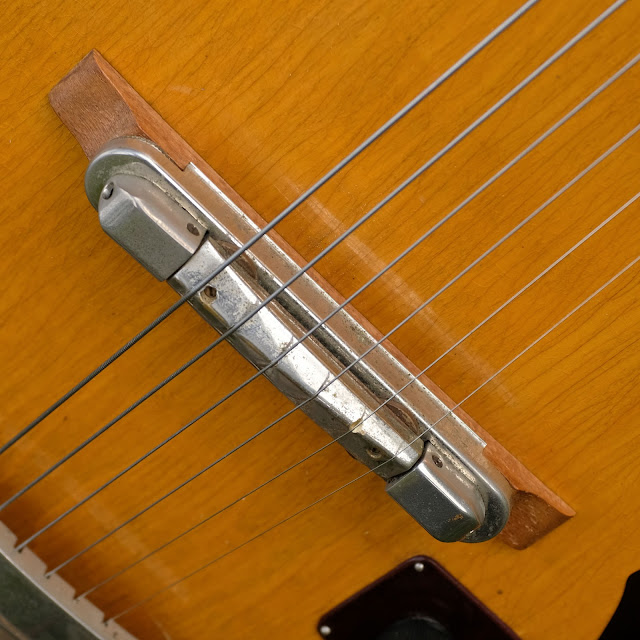1949 National 1111 Aristocrat Archtop Electric Guitar
While this instrument came into the shop via a repairs customer, I used one of these for gigs for a bit last year and really loved everything about it except that the 17" width didn't agree with my arm for sit-down shows. Still, I had a tug at my heart the moment the owner of this guitar took it out of its case. This is my kind of classy!
It has the lusty lines of the Gibson-supplied ES-300 body combined with the Chicago-chic National "Stylist" neck and its kick-butt deco inlay scheme. Mix and match that with the Gibson-supplied deluxe tailpiece and a pair of weirdo National electric pickups (one of which was an in-bridge "acoustic" unit) and you have an inspired design that was ahead of the curve for the time.
A quick note on the National-built neck is that it has a big metal core running all the way through it and into the headstock right to the top of the National logo inlaid in it. The mahogany exterior is almost just a "veneer" as it's 1/4" thick at most at any point. The neck is thus pretty durable and this construction affords the use of the awesome, 3-point adjustable-heel gizmo that lets one set neck angle on the fly and gives neck access all the way to the 14th fret with no heel interruption.
A quick note on the National-built neck is that it has a big metal core running all the way through it and into the headstock right to the top of the National logo inlaid in it. The mahogany exterior is almost just a "veneer" as it's 1/4" thick at most at any point. The neck is thus pretty durable and this construction affords the use of the awesome, 3-point adjustable-heel gizmo that lets one set neck angle on the fly and gives neck access all the way to the 14th fret with no heel interruption.
My work on this included a fretboard plane and refret with jumbo stock, a new wiring harness, general cleaning, some repair to the headstock veneer and inlays, a new bone nut, and a good setup. The owner supplied D'Addario Chromes flatwounds in 48w-11 gauges and they're perfect with the bright, snappy, Johnny Smith-ish, mini-humbucker-like neck pickup. I had to ditch the non-functional bridge pickup from the circuit, but at least it's still on the guitar and the neck pickup is (thankfully) strong and working. Action is spot-on, the neck is straight, and the new frets make this feel a lot more "pro." I kept the radius of the board the same as it was to begin with -- a compound one running from about 8" at the nut to 10" at the 7th fret and beyond.
Specs are: 24 7/8" scale, 1 11/16" nut width, 1 7/16" string spacing at the nut, 2 1/8" spacing at the bridge, 17" lower bout, 12 1/2" upper bout, and 3 1/4" side depth at the endblock.
Materials are: thicker plywood body all-around (with maple veneer), metal-core (with mahogany-wrap) neck, rosewood fretboard and headstock veneer, and pearl inlay in the board. The hardware is entirely original on this instrument -- included the covered, sealed-back Kluson tuners.
Specs are: 24 7/8" scale, 1 11/16" nut width, 1 7/16" string spacing at the nut, 2 1/8" spacing at the bridge, 17" lower bout, 12 1/2" upper bout, and 3 1/4" side depth at the endblock.
Materials are: thicker plywood body all-around (with maple veneer), metal-core (with mahogany-wrap) neck, rosewood fretboard and headstock veneer, and pearl inlay in the board. The hardware is entirely original on this instrument -- included the covered, sealed-back Kluson tuners.
The two center "dots" are raised poles for the D&G strings. They're set for keeping the string-to-string balance correct for a wound-G set.
The bridge has a humbucking, magnetic, vibration-effect pickup installed in it that I couldn't get to work correctly (the last one I'd handled was dead as well), but I compensate the B-string slot and the guitar is happily in-tune up the neck.
Whereas the controls used to be volume/blend, they're now volume/tone for the single neck pickup. The old harness was really, really corroded and featured an old-style jack instead of a 1/4" one.
The back of the neck has plenty of wear and tear.
There was no strap button here to begin-with, but I did put this "relic" new one on in the same fashion that National began to do with this style of neck joint starting a year or two later.
Let's not forget to mention the original hard case, right?
Here's what the bridge pickup looks like "exploded" into its various parts. The base is magnetized and has two little humbucking coils rigged-up in series. Posts from the bridge saddle descend into this coil and in some way drive the unit. I've never heard one of these working, so I'm not sure what to make of the design.
When I put it back together, I did wire-up a new ground/lead for it and dangle it back into the body. Someone in the future may want to suss it out and wire the jack up in stereo for "electric" and "acoustic" sounds, right? Right!
























Comments